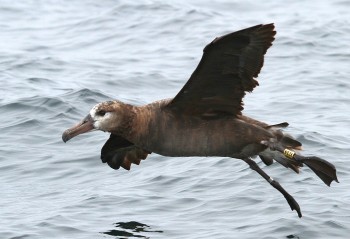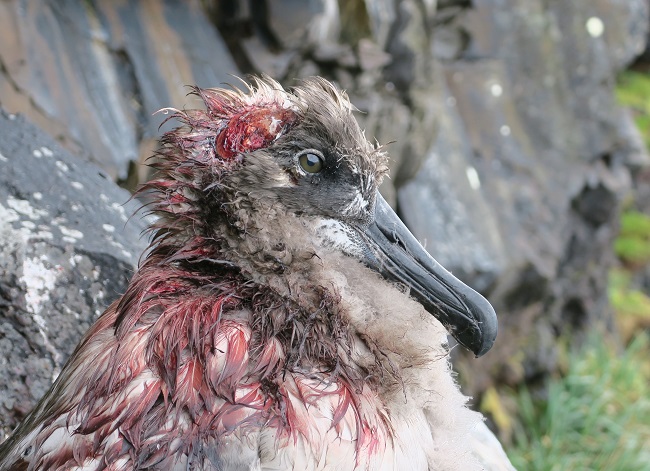ACAP Latest News
Read about recent developments and findings in procellariiform science and conservation relevant to the Agreement on the Conservation of Albatrosses and Petrels in ACAP Latest News.
For the third year running, New Zealand’s Department of Conservation has set up a webcam beside a nest in the mainland colony of globally Endangered Northern Royal Albatrosses Diomedea sanfordi at Taiaroa Head. The egg in the nest on view has recently hatched (click here).
“The egg was laid on 7 November 2017 and since then the parents (known as YWK and KGY) have been taking turns on the nest. They will now continue to take turns feeding the chick for the next five or six weeks. They then leave the chick unguarded, except for feeding visits, until it fledges in spring. The sex of the chick is unknown at this stage.”
Watch the albatross chick grow via the Royalcam here.

A colour-banded Northern Royal Albatross stands up on its egg at Taiaroa Head
There are 32 occupied nests in the colony in the current season, growing from one breeding pair in 1937 to about 65 pairs in 2017 (the species is a biennial breeder when successful).
John Cooper, ACAP Information Officer, 02 February 2018
Rowan Mott and Rohan Clarke (School of Biological Sciences, Monash University, Clayton, Australia) have published in the journal Emu - Austral Ornithology on geographic biases with studying seabirds at sea.
The paper’s abstract follows:
“The distribution of wildlife informs conservation planning. In marine systems, spatial information for seabirds is acquired primarily using vessel-based at-sea survey, aerial survey or animal-borne tracking devices. Many factors contribute to geographic biases in marine spatial research and we use a structured database search to review global patterns resulting from these biases. Although survey effort has been substantial, many large marine sectors were poorly represented. Poor representation often coincided spatially with hotspots of seabird species richness or areas experiencing high cumulative human impact, particularly in southern hemisphere and equatorial regions. Therefore, future seabird research priorities should reflect high species-richness areas including the south-west Pacific, particularly waters surrounding New Zealand. Furthermore, under-represented areas of Asia, and the Atlantic coasts of South America and Africa require greater research effort because of high cumulative human impacts in these areas. National gross domestic product (GDP) was positively related to the number of papers a country produced (determined by the first author’s address). This is indicative of constraints imposed by inherent costs of marine research. We recommend international collaboration between scientists from high-GDP nations with those in developing countries to address this. Further uptake of platforms of opportunity may also reduce this imbalance.”

A Black-footed Albatross Phoebastria nigripes at sea in the North Pacific, photograph by Vicki Miller
Reference:
Mott, R. & Clarke, R.H. 2018. Systematic review of geographic biases in the collection of at-sea distribution data for seabirds. Emu - Austral Ornithology. DOI:10.1080/01584197.2017.1416957.
John Cooper, ACAP Information Officer, 01 February 2018
Oliver Padget (Department of Zoology, University of Oxford, UK) and colleagues have written in the journal Current Biology on compass orientation in Manx Shearwaters Puffinus puffinus.
The paper’s summary follows:
“Compass orientation is central to the control of animal movement from the scale of local food-caching movements around a familiar area in parids [1] and corvids [2, 3] to the first autumn vector navigation of songbirds embarking on long-distance migration [4–6]. In the study of diurnal birds, where the homing pigeon, Columba livia, has been the main model, a time-compensated sun compass [7] is central to the two-step map-and-compass process of navigation from unfamiliar places, as well as guiding movement via a representation of familiar area landmarks [8–12]. However, its use by an actively navigating wild bird is yet to be shown. By phase shifting an animal’s endogenous clock, known as clock-shifting [13–15], sun-compass use can be demonstrated when the animal incorrectly consults the sun’s azimuthal position while homing after experimental displacement [15–17]. By applying clock-shift techniques at the nest of a wild bird during natural incubation, we show here that an oceanic navigator—the Manx shearwater, Puffinus puffinus—incorporates information from a time-compensated sun compass during homeward guidance to the breeding colony after displacement. Consistently with homing pigeons navigating within their familiar area [8, 9, 11, 18], we find that the effect of clock shift, while statistically robust, is partial in nature, possibly indicating the incorporation of guidance from landmarks into movement decisions.”

Manx Shearwater, photograph by Nathan Fletcher
Reference:
Padget, O., Bond, S.L., Kavelaars, M.M., van Loon, E., Bolton, M., Fayet, A.L., Syposz, M., Roberts, S. & Guilford, T. 2018. In situ clock shift reveals that the sun compass contributes to orientation in a pelagic seabird. Current Biology doi.org/10.1016/j.cub.2017.11.062.
John Cooper, ACAP Information Officer, 31 January 2018
ACAP Latest News has regularly reported on the deprivations introduced House Mice Mus musculus are causing to surface- and burrow-nesting seabirds on South Africa’s sub-Antarctic Marion Island, including to four species of ACAP-listed and globally threatened albatrosses (click here).

A Light-mantled Sooty Albatross Phoebetria palpebrata "scalped" by mice on Marion Island, photograph by Peter Ryan
In the most recent posting describing disturbing attacks by mice on Marion’s albatrosses it was stated that “South Africa is now considering making an eradication attempt on the island, as briefly mentioned in its Implementation Report (AC10 Inf 10) to ACAP’s meetings in Wellington, New Zealand [last year]” (click here).
As well as by research publications listed in the recent post this consideration was influenced by a feasibility study conducted in 2015 by island eradication expert John Parkes from New Zealand. Inter alia, his feasibility study calls for increased knowledge of the island’s mice needed to ensure a high chance of their eradication.
An Environmental Officer to spend a year on the island from April is to be appointed. The appointee’s work programme will concentrate on conducting field work on the mice with the following topics to be covered:
- Conduct a large-scale bait uptake trial by mice at Marion Island in May 2018;
- Assess lethal doses of poison bait on captive mice;
- Conduct regular surveys of mouse breeding status over winter (April-October);
- Estimate crude densities of mice across an altitudinal gradient through the target baiting period (May-September); and
- Monitor cloud heights over the baiting window using remote cameras.
Read more here.
Reference:
Parkes, J. 2016. Eradication of House Mice Mus musculus from Marion Island: a review of feasibility, constraints and risks. BirdLife South Africa Occasional Report Series No. 1. Johannesburg: BirdLife South Africa.
John Cooper, ACAP Information Officer, 30 January 2018
- An Atlantic Yellow-nosed Albatross gets freed from a deliberately tied packing strap
- The 14th International Seabird Group Conference, Liverpool, UK, 3-6 September 2018 opens for business
- Amsterdam and Shy Albatrosses up for status review: BirdLife International calls for involvement with its Forum for Globally Threatened Seabirds
- New MPAs for Greece help protect Scopoli’s and Yelkouan Shearwaters
© 2024 ACAP. All rights reserved. Privacy Policy Manage Your Data LoginLogout

 English
English  Français
Français  Español
Español 